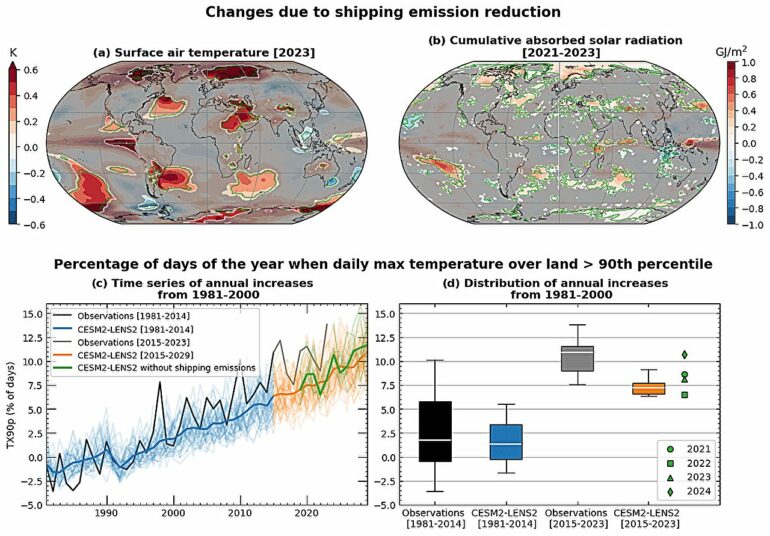The summer of 2023 saw a surprising increase in global temperatures, even within the context of the ongoing greenhouse gas-driven warming trend. Many scientists were flummoxed. Their simulations didn’t show this kind of spike.
“Climate scientists were saying this is essentially impossible, that it is bonkers to see such a jump all at once,” said Daniele Visioni, assistant professor in the Department of Earth and Atmospheric Sciences. “People were saying, ‘Climate change is suddenly accelerating.’ We’d never seen something like this.”
Visioni’s paper, “Modeling 2020 Regulatory Changes in International Shipping Emissions Helps Explain Anomalous 2023 Warming,” published Nov. 28 in Earth System Dynamics, gets to the bottom of it.
Mandated reductions in sulfate emissions from international shipping routes in 2020 are partly responsible for the record high temperatures, the researchers found. Reducing the amount of aerosol particles in the atmosphere reduces cloud coverage; thus, clouds’ ability to reflect solar radiation back to space is diminished.
The paper’s findings suggest future policy decisions around abrupt reductions in tropospheric aerosols should take into account their surface temperature impact.
Past research indicated that such change would lead to a minor increase in the global temperature due to a reduction in cloud formation, but Visioni and co-author Ilaria Quaglia, postdoctoral researcher in the Sibley School of Mechanical and Aerospace Engineering (Cornell Engineering), used Earth system model simulations to prove the significance of the sudden drop in sulfate shipping emissions.
These changes in the shipping industry had been discussed for years, Visioni said, with the International Maritime Organization (IMO) making a decision in 2014 to begin enforcing stricter sulfate emissions by 2020. Fuels with lower sulfur are much more expensive, so it took some time for the industry to adjust, he said.
The regulation required ships to use fuel with a sulfur content of no more than 0.5%, down from the previous limit of 3.5%. This reduction led to a more than 80% decrease in total sulfur oxide emissions from shipping.
And while there was some talk of this tradeoff within the shipping industry, he said, there was little attempt to call widespread attention to the potential effect.
“There was no attempt to say we should have all eyes on the shipping corridor,” Visioni said. “In hindsight, it would have been great to study that four years ago before the problem manifested itself.”
The Cornell researchers looked at monthly global temperature anomalies over the period 2020–23, removing the assumed linear contribution from greenhouse gases and seasonality, in order to determine the shipping industry’s impact on temperature anomalies. They found that removing sulfur dioxide from shipping fuel likely increased the planet’s temperature by 0.08°C.
“The unprecedented heat became a normal warm year once you accounted for that,” Visioni said.
Quantifying how much these polluting aerosols reflect heat back into space to make a noticeable increase in the Earth’s temperature is not, Visioni said, a suggestion that these pollution-cutting efforts should be curtailed.
Discover the latest in science, tech, and space with over 100,000 subscribers who rely on Phys.org for daily insights.
Sign up for our free newsletter and get updates on breakthroughs,
innovations, and research that matter—daily or weekly.
“Air quality improvement is immediate, and everyone is always going to go for that. A lesson here is we make decisions about trade-offs all the time,” he said. “We are reducing air pollution more than was predicted 10 years ago, so there needs to be a lot more open discussion. It means the urgency of emission reduction is even greater.”
The shipping industry has, like many industries, shifted toward alternative fuels to meet the IMO’s decarbonization goals, and methanol, hydrogen, ammonia, wind-assisted propulsion systems and other technologies are gaining traction.
“We need to be more forceful about emissions reductions,” Visioni said. “We have to bridge a gap. But we should work to prevent warming of the planet through other means. Cloud brightening, geoengineering climate interventions—these are not things that are going to reduce emissions, but they are things we might need to prevent further warming.”
More information:
Ilaria Quaglia et al, Modeling 2020 regulatory changes in international shipping emissions helps explain anomalous 2023 warming, Earth System Dynamics (2024). DOI: 10.5194/esd-15-1527-2024
Provided by
Cornell University
Citation:
Shipping emissions reduction in 2020 led to 2023 temperature spike, study finds (2025, January 8)



